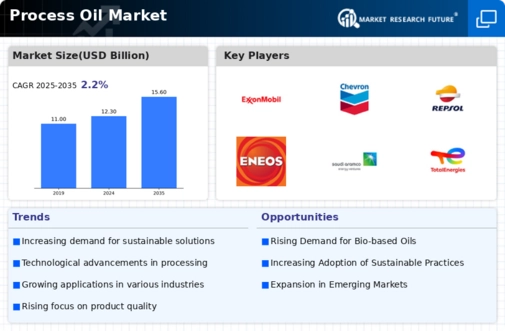Market Trends and Charts
Growth of the Automotive Sector
The automotive sector plays a pivotal role in the expansion of the Global Process Oil Market Industry. With the increasing production of vehicles and the rising demand for high-performance tires, the need for specialized process oils is on the rise. These oils are essential in enhancing the durability and performance of tires, which is crucial for consumer safety and satisfaction. As the automotive industry continues to evolve, particularly with the shift towards electric vehicles, the demand for innovative process oils is expected to grow. This trend indicates a promising future for the Global Process Oil Market Industry, with potential revenue growth as the sector expands.
Emerging Markets and Economic Growth
Emerging markets are becoming increasingly significant in the Global Process Oil Market Industry. Countries in Asia-Pacific and Latin America are witnessing rapid industrialization and urbanization, leading to heightened demand for process oils in various applications. This economic growth is accompanied by an increase in manufacturing activities, particularly in rubber and plastics, which are key consumers of process oils. As these regions continue to develop, the Global Process Oil Market Industry is likely to benefit from this expanding consumer base. The potential for growth in these emerging markets suggests a favorable outlook for the industry in the coming years.
Increasing Environmental Regulations
The Global Process Oil Market Industry is influenced by the tightening of environmental regulations across various regions. Governments are implementing stricter guidelines to reduce the environmental impact of industrial processes, prompting manufacturers to seek eco-friendly alternatives. This shift towards sustainable practices is driving the demand for biodegradable and non-toxic process oils. As industries adapt to comply with these regulations, the market for environmentally friendly process oils is likely to expand. This trend not only reflects a growing awareness of sustainability but also positions the Global Process Oil Market Industry for potential growth in the coming years.
Rising Demand from End-User Industries
The Global Process Oil Market Industry experiences a notable surge in demand driven by various end-user sectors, including automotive, rubber, and plastics. These industries increasingly rely on process oils for their manufacturing processes, enhancing product performance and quality. For instance, the automotive sector utilizes process oils in tire production, which is projected to grow significantly. As of 2024, the market is valued at approximately 12.3 USD Billion, indicating a robust demand trajectory. This trend suggests that as these industries expand, the Global Process Oil Market Industry will likely witness sustained growth, potentially reaching 15.6 USD Billion by 2035.
Technological Advancements in Oil Processing
Technological innovations in oil processing techniques contribute significantly to the growth of the Global Process Oil Market Industry. Advanced refining methods and the development of synthetic process oils enhance product efficiency and environmental compliance. For example, the introduction of bio-based process oils aligns with sustainability goals, appealing to environmentally conscious consumers. These advancements not only improve product performance but also reduce production costs, thereby attracting more manufacturers. As the industry adapts to these technological changes, the Global Process Oil Market Industry is expected to maintain a steady growth rate, with a projected CAGR of 2.19% from 2025 to 2035.



















